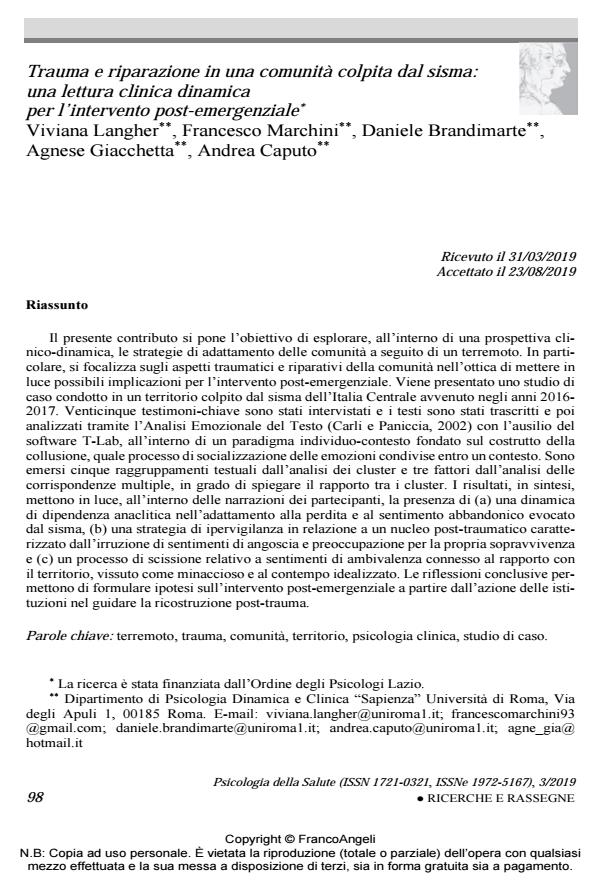Trauma and reparation in a community struck by earthquake: a clinical dynamic interpretation for post-emergency intervention
Journal title PSICOLOGIA DELLA SALUTE
Author/s Viviana Langher, Francesco Marchini, Daniele Brandimarte, Agnese Giacchetta, Andrea Caputo
Publishing Year 2019 Issue 2019/3
Language Italian Pages 24 P. 98-121 File size 278 KB
DOI 10.3280/PDS2019-003006
DOI is like a bar code for intellectual property: to have more infomation
click here
Below, you can see the article first page
If you want to buy this article in PDF format, you can do it, following the instructions to buy download credits

FrancoAngeli is member of Publishers International Linking Association, Inc (PILA), a not-for-profit association which run the CrossRef service enabling links to and from online scholarly content.
The present study aims at investigating the community adaptation strategies to an earth-quake according to a clinical-dynamic perspective. In particular, it aims at highlighting traumat-ic and reparative aspects of community in order to widely inform post-emergency interven-tions. A case-study conducted in an area affected by Central Italy earthquake was conducted in 2016-2017. Twenty-five key-figures were interviewed and their texts were analyzed through Emotional Text Analysis (Carli e Paniccia, 2002) utilizing T-lab software, according to a indi-vidual-context paradigm based on the construct of collusion intended as a socialization process of shared emotions within the same context. Five textual groupings were detected through cluster analysis and three factors, through multiple correspondence analysis, allowing the ex-planation of their relationships. Results from participants’ narratives, in summary, showed (a) a dynamic of anaclitic dependence to adapt to loss and abandonment feelings evoked by earth-quake, (b) a strategy of hypervigilance related to a post-traumatic core featured by anxiety and worry about survival, and (c) a splitting process regarding ambivalent feelings towards territo-ry perceived as threatening but also idealized. Conclusive reflections shed light on potential post-emergency intervention such as the role of institutions in leading to post-trauma recovery.
Keywords: Earthquake, trauma, community, territory, clinical psychology, case-study.
- A systematic review of psychodynamic theories in community psychology: Discovering the unconscious in community work Andrea Caputo, Manuela Tomai, in Journal of Community Psychology /2020 pp.2069
DOI: 10.1002/jcop.22407 - The Impact of Past Trauma on Psychological Distress: The Roles of Defense Mechanisms and Alexithymia Siqi Fang, Man Cheung Chung, Yabing Wang, in Frontiers in Psychology 992/2020
DOI: 10.3389/fpsyg.2020.00992
Viviana Langher, Francesco Marchini, Daniele Brandimarte, Agnese Giacchetta, Andrea Caputo, Trauma e riparazione in una comunità colpita dal sisma: una lettura clinica dinamica per l’intervento post-emergenziale in "PSICOLOGIA DELLA SALUTE" 3/2019, pp 98-121, DOI: 10.3280/PDS2019-003006